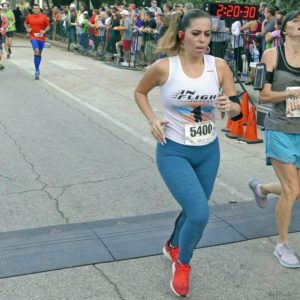The bad news for the female runner is that she is more likely than her male counterpart to suffer certain types of injuries. The good news is that, with proper education and the right tips on injury prevention, she can minimize such injuries or eliminate them altogether.
As a sports medicine podiatrist who treats a large number of female patients, I am often asked why women experience so many mal-alignment and overuse injuries. The answer lies in the female’s physical development anatomy. When the female enters puberty and her hips broaden relative to her waist and shoulders, her pelvis begins to widen and a change at the hip occurs. This creates an accompanying change of the knees, often referred to as “knock knees”. The more “knock”, the greater the quadriceps pull. As a result, sports medicine doctors see many overuse injuries affecting the hip, knee, shin and ankle of the female runner.
I have identified five injuries common to the female runner – scoliosis, foot type and deformities, Achilles tendonitis, knee injuries and stress fractures – and suggested how to deal with them.
Scoliosis
This curvature of the spine is most prevalent in female adolescents, occurring 85 percent of the time. It can contribute to the lower back and hip pain with running. It can also cause a pelvic tilt, where one limb acts longer than the other. This almost always develops into an overuse injury to the shorter limb.
Recommended prevention: Measure the shorter limb and equalize it to the other limb to reduce the potential for overuse injuries. This can be accomplished either by using a prescription orthotic heel lift.
Foot Type & Deformity
If a woman has a flat foot or pronates excessively and had ligamentous laxity, she had a greater chance of developing a bunion of hammertoes. Unfortunately, the problem is often compounded by shoewear designed primarily for the male foot. The female forefoot is wider and her hind foot narrower, requiring a differently shaped shoe.
Recommended prevention: A running shoe designed for motion control and stability. If necessary see a sports medicine doctor to request a prescription orthotic that will control the excessive pronation.
Achilles Tendonitis
In addition to placing pressure on the ball of the foot and causing pain on the metatarsal head bones, sesamoiditis, and Morton’s neuroma (nerve entrapment), women who wear high-heeled shoes tend to shorten the Achilles tendon. This can lead to a typical overuse injury such as chronic Achilles tendonitis or a behind-the-heel spur (pump bump).
Recommended prevention: Plenty of stretching performing correctly and without bouncing, holding the stretch 20-30 seconds. Good suggestions: wall-calf/Achilles stretches and step-heel/call decline stretches.
Knee Injury
As we noted earlier, because a women’s pelvis is wider than a man’s, her hips rotate inward and downward, causing and accompanying the change of the knees, often referred to as “knock knees”. The more “knock”, the greater the quadriceps pull, and the greater the chance of injury to the knee. A weak quadricep muscle or mal-alignment of the knee cap can often lead to overuse “runner’s knee” injury.
Recommended prevention: Shoes that have motion control prevent the knees pendulum swing. A prescription orthotic may also help. Quadriceps muscle strengthening is often beneficial.
Stress Fractures
Seen most often in females who do not menstruate and/or suffer from osteoporosis due to a decrease in bone mineral density, stress fractures can result from extreme biomechanical stress on a weakened bone. Activity, training, and intensity increase the incidence of stress fractures in amenorrheic (non-menstruating) women. The prevalence of such an injury increases dramatically as the weekly running mileage exceeds 20 miles.
With the more common incidence of eating disorders in women, improper nutrition is another factor that can lead to stress fractures. Anorexia nervosa and bulimia nervosa are two eating disorders that can contribute to injury and even death.
Recommended prevention: It goes without saying that a proper diet, medical attention for amenorrhea and appropriate hormone therapy will address the problem of demineralization of the bone. In addition, a greatly reduced mileage schedule or complete cessation of running may be necessary to allow for complete healing and prevent recurrent injury.
Patient education is a must to prevent “down time”. Eating disorder, amenorrhea and osteoporosis must be addressed early and have a team approach to care. Proper diagnosis and treatment, in addition to psychological counseling, may be imperative.
Understanding causes of injuries, together with videotaping of a runner’s gait, can often illustrate the nature of an injury. Muscle strengthening, flexibility, biomechanical and other evaluation can prove very helpful in preventing many of these problems.
The female anatomy, physiology, and even her psychology require specific understanding, particularly in cases of pregnancy and hormonal shifts. With patient education and the tips mentioned on injury prevention, the female runner can minimize or eliminate potential problems.
Dr. Ross is a Podiatrist, M.D. in private practice in Houston, TX. He is a Clinical Assistant Professor for the Baylor College of Medicine and a Fellow for the American College of Foot and Ankle Surgeons. To book an appointment with Dr. Ross or find out about his services he can be reached at 713.798.5700.

